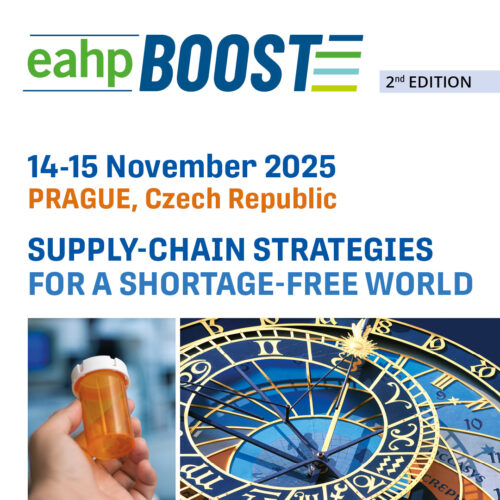PATIENT SAFETY: INTERVENTIONS TO REDUCE RISKS IN MEDICATION USE PROCESSES
Pdf

European Statement
Patient Safety and Quality Assurance
Author(s)
Nadia El Hilali Masó, Elvira Ramió Montero, Gemma Baronet Jordana, Marina De temple Pla, Paula Montoliu Alcon, Maria Jaume Gaya, Núria Pi Sala, Joan Altimiras Ruiz, Montserrat Pons Busoms
Why was it done?
The confusion between drug names represents a common cause of medication errors due to similarities between trade names and active ingredients or vice versa. Very new drugs coexisting with others that are very well known can easily induce errors in wards, unclear prescription may lead to misunderstanding of prescription.
What was done?
Development and implementation of measures to improve patient’s safety from purchase to drug prescription and administration.When we switch to a new provider maybe forced by drug shortage, we perform a review to avoid medication errors in all dosage forms.If needed, we elaborated alerts (pharmalerts) and newsletters. We applied Tall Man letters (TML) method to manage look-alike and sound-alike drugs, and to reduce prescription errors we elaborated a “Best practices on drug prescription” validated by Commission of pharmacy.
How was it done?
We prepared a formulary online on the intranet where pharmacist introduces relevant drug information as composition (i.e, excipients, contents latex or not, etc.), dilution, stability, source of errors (name, brand name,etc) among others. We compare them with existing ones to take an action, if necessary, that will be spread to all professionals. To implement TML method we followed the ISMP recommendations. First, we selected 3 antibiotics: cefOTAXime, cefAZOLin, cefTRIAXone. We changed these names in the prescription program so that the differentiation is reflected when drugs are prescribed, dispensed and administered. The implementation was explained to pharmacy, nursery and medical staff.After a month, we evaluated its acceptance.
What has been achieved?
We reviewed 61 new products: 50 trademarks, 14 new drugs and 7 dosage forms. 70.48% of products, acquired temporally or permanently, were new trademarks; 19.71% new drugs and 9.81% new dosage forms. The review is a good tool for a safe use of drugs and improves communication between healthcare providers. To evaluate TML implementation 240 questionnaires were completed: Acceptance was 92.05% (nursery and medical staff). 91.17% thought that it is possible to make a mistake with look-alike or sound-alike drugs and 68.72% that TML is useful to minimise medication errors.
What next?
The huge acceptance of TML encourages us to select other drugs from ISMP list. We have 6 pairs of drugs. We are planning to extend its use to storage shelves on wards.
DEVELOPING A PROJECT FOR BROADCASTING INFORMATION ABOUT MEDICATION ERRORS
Pdf

European Statement
Patient Safety and Quality Assurance
Author(s)
Sergio Plata-Paniagua, Alfredo Montero-Delgado, Jose Javier Arenas-Villafranca
Why was it done?
Currently, with the extended use of social-networks (SN), information related to medication errors can be disseminated quickly and directly, and also provide interaction with professionals enhancing the information. This is very important to promote safety culture among health professionals to prevent medication errors.
What was done?
Two hospital pharmacy specialists from two spanish hospitals created a project based on web 2.0 to broadcast information about medication errors and how to prevent them.
How was it done?
First step was to create a website in which we could post information related to medication errors. The main part of the website is the blog, where we develop all information that we consider interesting. The website also has other sections containing useful resources: photo gallery with examples of look/sound-alike drugs, infographics, educational information, information about the authors and a section where readers can share content with the authors.
Second step was to create accounts on SN to spread the information posted in the website and also for sharing original content. We chose Twitter and Facebook as ideal SN. Twitter allows sharing information quickly and concisely and also is used by a different groups of healthcare providers by allowing us a wide spread. On the other hand, Facebook allows us to reach to a different audience, especially patients.
What has been achieved?
-Currently we have more than 16.000 followers on Facebook, 5.500 on Twitter and the website receives more than 3.500 monthly visits.
-Because of the multiple warnings that we have carried out about Look-Alike/Sound-Alike drugs, some pharmaceutical companies have considered changing the packaging of their drugs.
-We have achieved more than 70.000 signatures on change.org website requesting Spanish healthcare authorities to develop guidelines for the proper packaging and labeling of drugs. Because of this initiative, the Spanish press became interested in this problem and our project and the problem of drug packaging was mentioned in multiple media.
What next?
Currently, we have included another pharmacist in our project in order to enhance the quality and periodicity of our publications. On the other hand, we are trying to work together with institutions dedicated to preventing medication errors to carry out joint projects in order to improve patient safety.
























